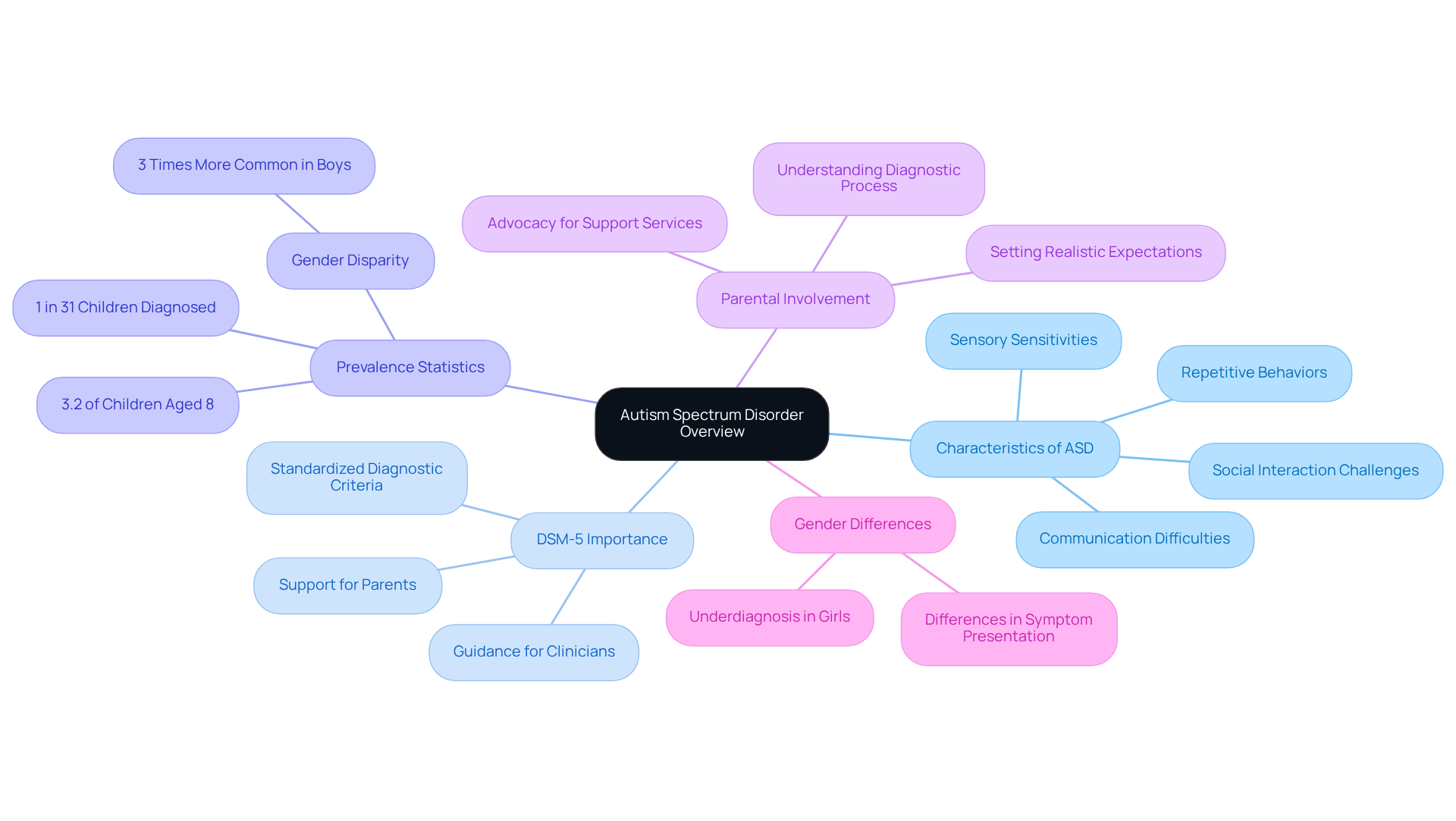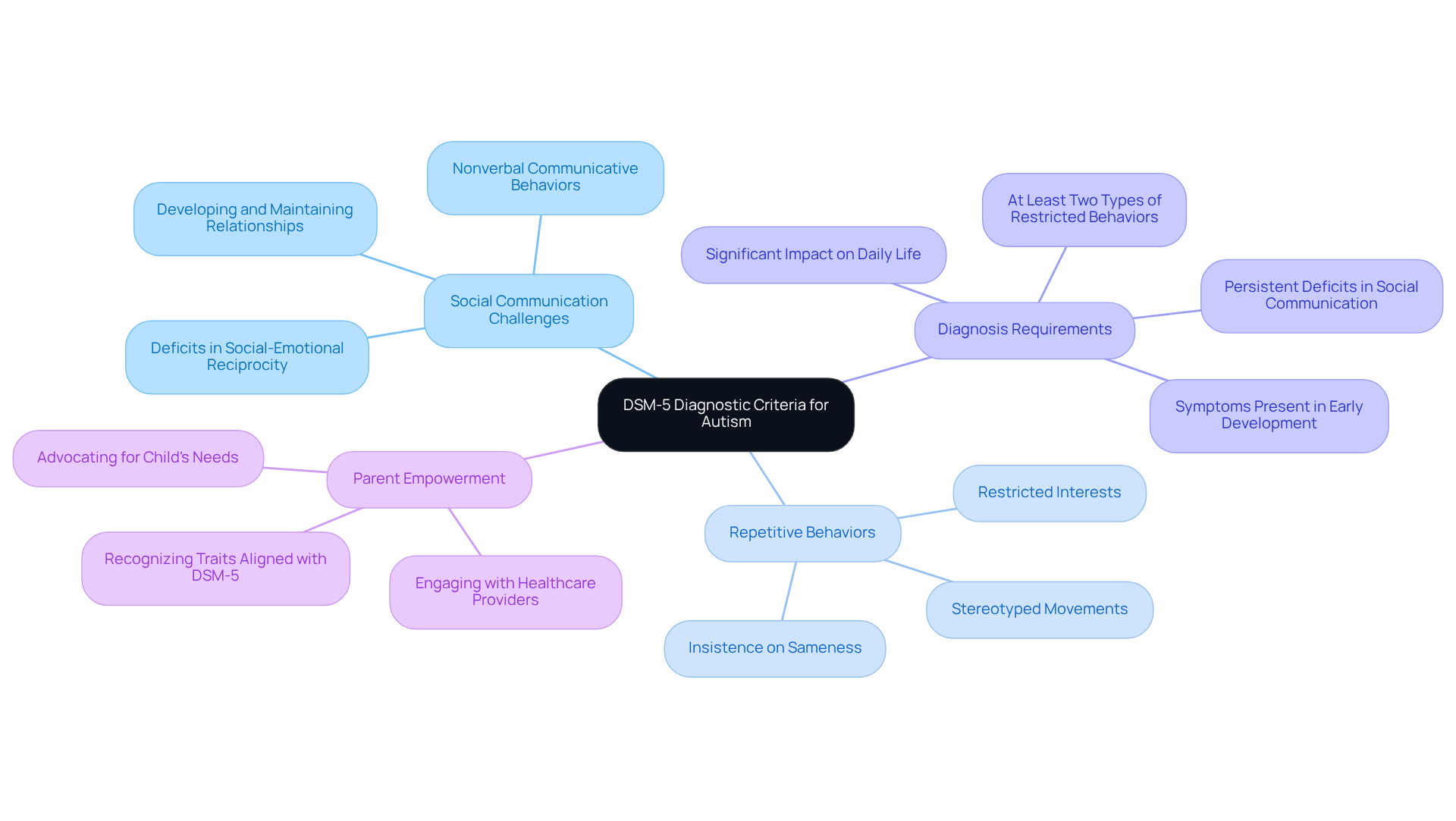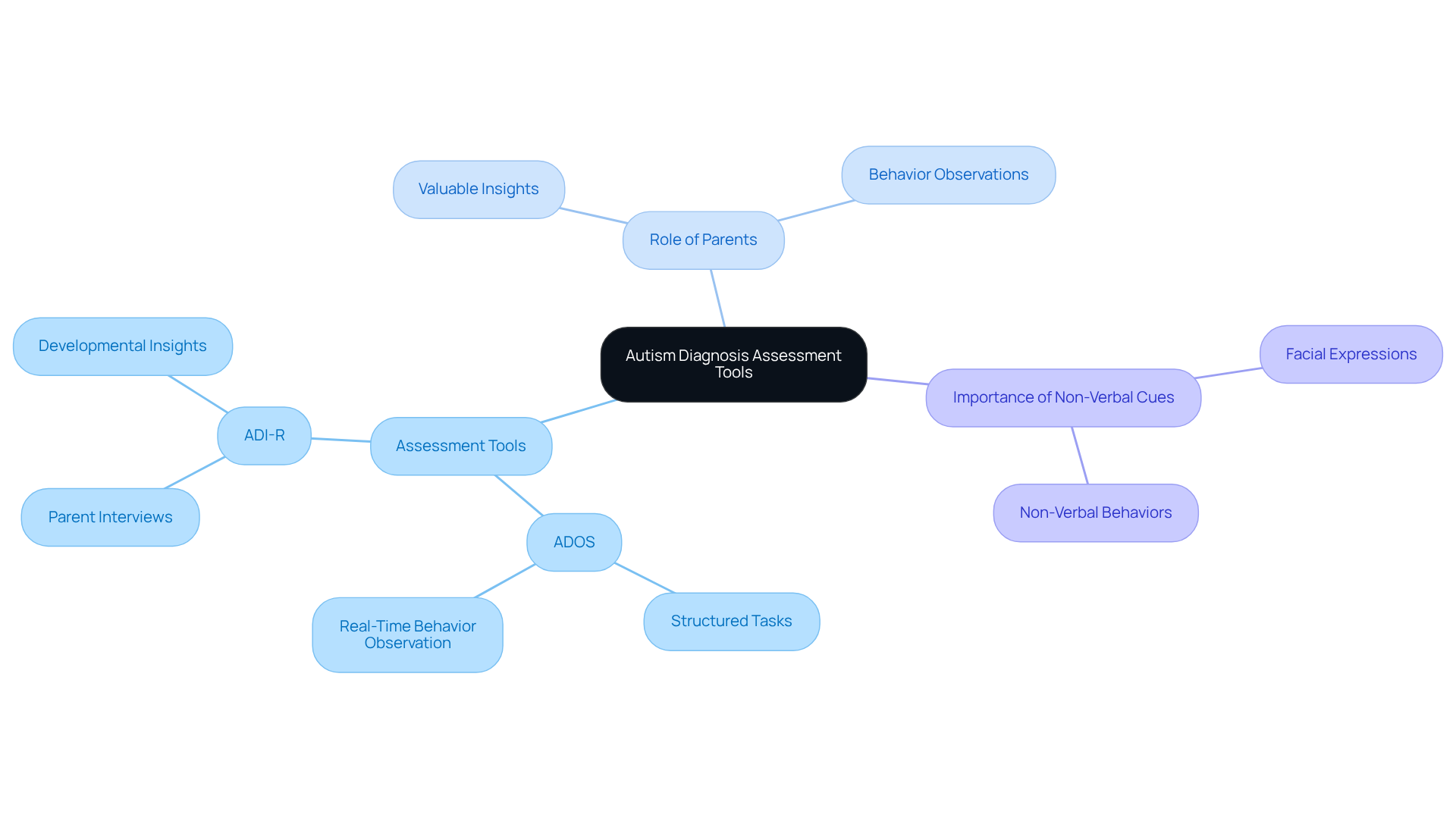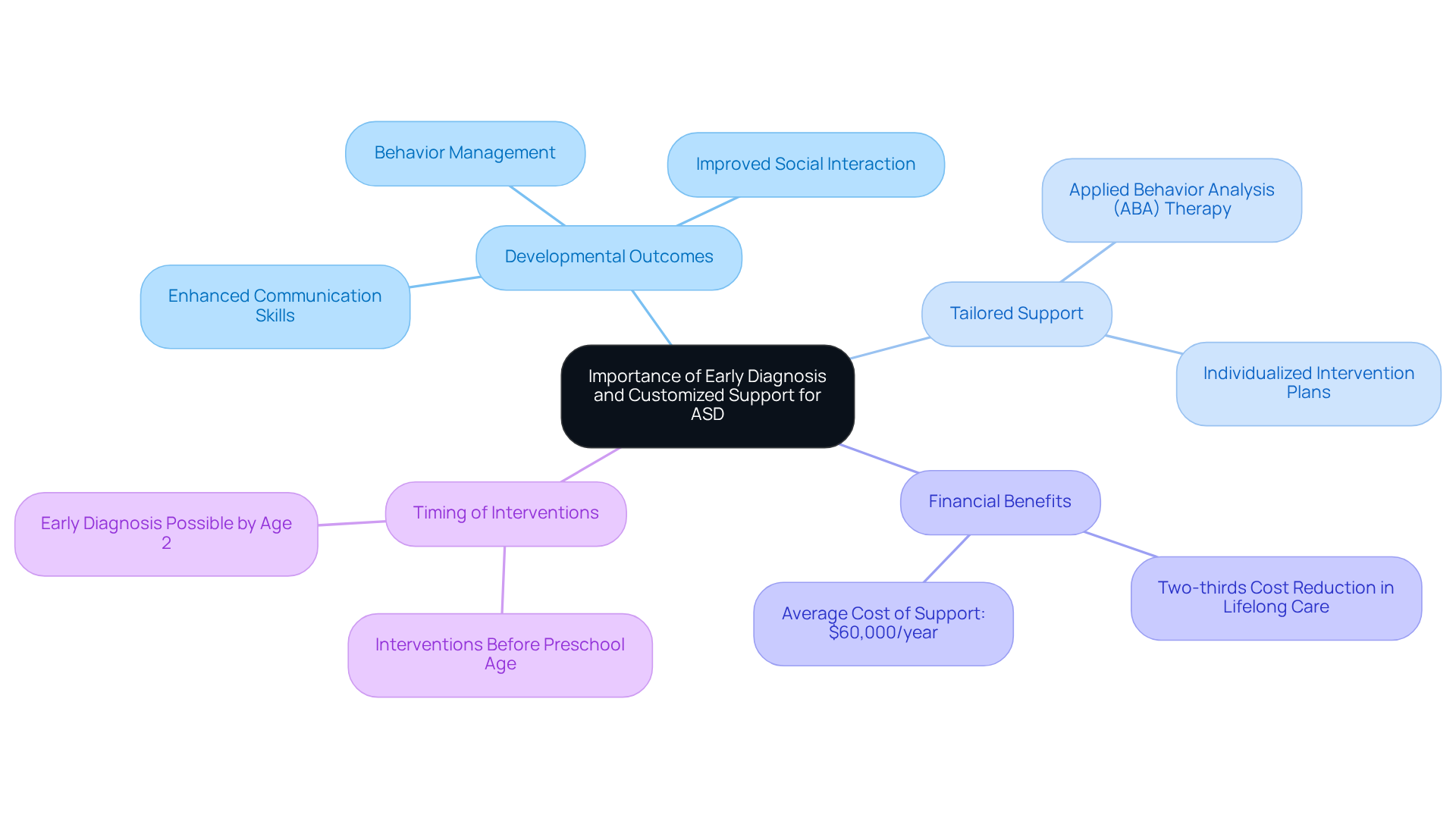Overview
Navigating the DSM-5 autism test can feel overwhelming for parents, but understanding Autism Spectrum Disorder (ASD) is crucial for supporting your child effectively. By familiarizing yourself with the diagnostic criteria and assessment tools, you empower yourself to advocate for timely interventions. Imagine the difference this knowledge can make in enhancing your child's developmental outcomes and overall quality of life.
As you embark on this journey, consider the challenges you face. Many parents share stories of uncertainty and concern when it comes to understanding their child's needs. You're not alone in this experience; countless families have walked this path and found ways to thrive.
It's essential to seek out resources and support that cater to your unique situation. By connecting with professionals and other parents, you can gain insights and strategies that resonate with your experiences. Remember, your advocacy plays a pivotal role in your child's journey.
In conclusion, take the first step today. Equip yourself with knowledge, reach out for support, and become the advocate your child needs. Together, we can create a brighter future for children with ASD.
Introduction
Understanding Autism Spectrum Disorder (ASD) is crucial for parents as they navigate the complexities of their child's development. With the prevalence of ASD continuing to rise, affecting approximately 1 in 31 children in the U.S., it’s more important than ever to feel supported and informed.
The DSM-5 autism test serves as a vital tool in this journey, providing standardized criteria that not only aid in accurate diagnosis but also empower parents to advocate effectively for their child's needs. Yet, the diagnostic process can often feel overwhelming and confusing.
How can parents ensure they are fully equipped to support their children and engage in meaningful conversations with healthcare professionals?
This journey is not just about understanding a diagnosis; it’s about fostering a nurturing environment where both parents and children can thrive together.
Clarify Autism Spectrum Disorder and DSM-5 Overview
Autism Spectrum Disorder (ASD) is a multifaceted neurodevelopmental condition characterized by challenges in social interaction, communication, and repetitive behaviors. The DSM-5 autism test, which is part of the Diagnostic and Statistical Manual of Mental Disorders, Fifth Edition, serves as a vital resource for healthcare professionals in diagnosing mental health conditions, including ASD. It provides standardized criteria that enable clinicians to effectively assess and categorize the severity of autism through the DSM-5 autism test. As of 2025, approximately 1 in 31 children in the U.S. has been identified with ASD, reflecting the growing recognition and diagnosis of this condition. According to the CDC's ADDM Network, 3.2% of children aged 8 years have been identified with ASD, offering a broader context for its prevalence.
For parents, understanding the meanings and categories within the manual is crucial. It equips them to engage in informed discussions about their child's assessment and treatment options. Familiarity with the manual's framework can clarify the diagnostic process, helping parents set realistic expectations for their child's development and the available interventions. Recent research highlights the importance of early identification, with studies indicating that autism can be reliably recognized by age 2. However, the average identification age in the U.S. is 5 years. This gap underscores the urgent need for timely interventions, which can significantly enhance quality of life.
Mental health experts emphasize that understanding the diagnostic criteria, such as the DSM-5 autism test, not only aids in accurate diagnosis but also fosters a supportive environment for families facing the challenges of autism. Dr. Cuffman notes, "Understanding the criteria of the diagnostic manual is essential for parents to advocate effectively for their children." Real-life examples illustrate how parents have successfully utilized the diagnostic guidelines to ensure their children receive the necessary support and resources. Additionally, it is vital to recognize that ASD is over three times more prevalent in boys than in girls, highlighting the need for awareness and understanding of gender differences in identification. By comprehending the manual for mental disorders, parents can navigate the autism assessment landscape more effectively, ultimately unlocking their child's potential.

Explore DSM-5 Diagnostic Criteria for Autism
Understanding Autism Spectrum Disorder (ASD) is crucial for parents who want to support their children effectively. The DSM-5 autism test outlines specific diagnostic criteria for ASD, highlighting persistent challenges in social communication and interaction across various situations. Additionally, it notes restricted and repetitive patterns of behavior, interests, or activities.
For a diagnosis, these symptoms must be evident during early development, significantly affect daily life, and cannot be better accounted for by another intellectual disability or global developmental delay. As a parent, familiarizing yourself with the criteria for the DSM-5 autism test can be incredibly helpful. It empowers you to recognize whether your child exhibits traits aligned with these diagnostic guidelines.
This understanding not only aids in identifying potential concerns but also enriches conversations with healthcare providers during evaluations. By engaging in these discussions, you can advocate for your child’s needs and ensure they receive the appropriate support. Remember, you are not alone in this journey; many parents share similar experiences and insights that can be invaluable.

Understand Assessment Tools and Methods for Autism Diagnosis
Assessing autism requires a compassionate approach that brings together standardized tests, observational assessments, and heartfelt conversations with parents and caregivers. Tools like the Autism Diagnostic Observation Schedule (ADOS) and the Autism Diagnostic Interview-Revised (ADI-R) are widely trusted in this journey. These evaluations focus on understanding a young person's social communication abilities, behavioral patterns, and developmental history. For instance, the ADOS features structured tasks that allow clinicians to observe behaviors in real time, while the ADI-R gathers comprehensive developmental insights through parent interviews.
Parents are invaluable in this process, offering essential perspectives on their child's behavior across different environments, which is crucial for an accurate diagnosis. Recent research highlights the importance of non-verbal cues, especially facial expressions, in diagnosing Autism Spectrum Disorder (ASD) at various stages of life. Additionally, clinicians note that while both ADOS and ADI-R are effective, the ADOS may provide more pertinent information for older adolescents and adults compared to the ADI-R.
By understanding these tools, parents can feel more empowered to actively participate in the assessment process, ensuring they provide the necessary context for their child's evaluation. This collaborative approach not only enhances the accuracy of the assessment but also fosters a nurturing environment for families as they navigate the complexities of autism evaluation. Together, we can create a supportive community that uplifts and guides each other through this journey.

Recognize the Importance of Early Diagnosis and Customized Support
Recognizing the importance of early diagnosis of Autism Spectrum Disorder (ASD) is vital for parents. Timely intervention can significantly enhance developmental outcomes for their children. Research shows that youngsters who receive early and tailored assistance are more likely to develop essential skills in communication, social interaction, and behavior management. For instance, interventions like Applied Behavior Analysis (ABA) therapy can be specifically designed to meet each child's unique needs, leveraging their strengths while addressing challenges.
Moreover, statistics reveal that early diagnosis and intervention can reduce the cost of lifelong care by two-thirds, highlighting both financial and developmental benefits. Parents are encouraged to advocate for early assessments and actively seek resources that offer personalized support. This proactive approach can profoundly influence their child's potential and overall well-being.
Current studies indicate that early interventions occur at or before preschool age, sometimes as early as 2 or 3 years old, yielding the most favorable outcomes. As the National Research Council emphasizes, "The sooner a child gets help, the greater the chance for learning and progress." By taking action now, parents can pave the way for a brighter future for their children.

Conclusion
Navigating the complexities of Autism Spectrum Disorder (ASD) and the DSM-5 autism test is essential for parents who wish to understand and support their children effectively. This article highlights the importance of being well-informed about the diagnostic criteria and assessment tools available, empowering parents to advocate for their children and secure the necessary support and interventions.
Key arguments emphasize the significance of early diagnosis and intervention, which can dramatically enhance developmental outcomes for children with ASD. By familiarizing themselves with the DSM-5 criteria, parents can engage in meaningful conversations with healthcare providers and take proactive steps toward obtaining tailored support. Additionally, understanding the prevalence of ASD and the differences in diagnosis between genders underscores the need for awareness and timely action in addressing these challenges.
Ultimately, the journey of navigating autism diagnosis and support requires collaboration, understanding, and advocacy. Parents are encouraged to take an active role in this process, utilizing the resources and insights available to them. By prioritizing early assessments and personalized interventions, they can significantly influence their child's potential and pave the way for a brighter future.
Frequently Asked Questions
What is Autism Spectrum Disorder (ASD)?
Autism Spectrum Disorder (ASD) is a neurodevelopmental condition characterized by challenges in social interaction, communication, and repetitive behaviors.
What role does the DSM-5 play in diagnosing ASD?
The DSM-5 provides standardized criteria for healthcare professionals to diagnose mental health conditions, including ASD, enabling effective assessment and categorization of its severity.
How prevalent is ASD among children in the U.S.?
As of 2025, approximately 1 in 31 children in the U.S. has been identified with ASD, with the CDC's ADDM Network reporting that 3.2% of children aged 8 years have been identified with the condition.
Why is it important for parents to understand the DSM-5?
Understanding the DSM-5 helps parents engage in informed discussions about their child’s assessment and treatment options, clarifying the diagnostic process and setting realistic expectations for development and interventions.
At what age can autism be reliably identified, and what is the average identification age in the U.S.?
Autism can be reliably recognized by age 2, but the average identification age in the U.S. is 5 years, highlighting a gap that calls for timely interventions.
How can understanding the diagnostic criteria benefit families?
Understanding the diagnostic criteria aids in accurate diagnosis and fosters a supportive environment for families, enabling them to advocate effectively for their children.
Is there a gender difference in the prevalence of ASD?
Yes, ASD is over three times more prevalent in boys than in girls, emphasizing the need for awareness and understanding of gender differences in identification.
How can parents utilize the diagnostic guidelines?
Parents can use the diagnostic guidelines to ensure their children receive necessary support and resources, helping them navigate the autism assessment landscape effectively.




